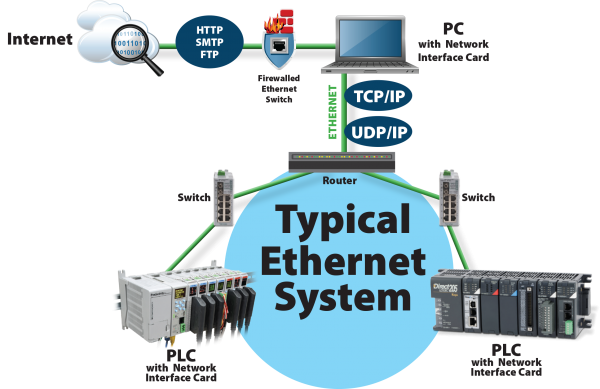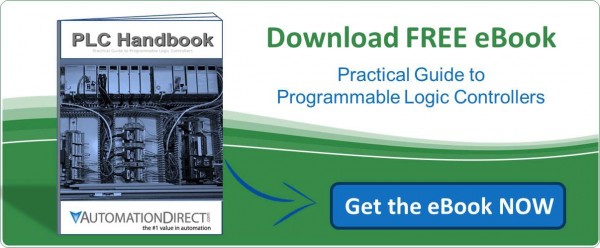For many, the world of communications is mystifying, shrouded in complexity and unknowns with equal parts science and magic, and 100% scary. We would like to define some common terms and show you how they fit together so you’ll find that networking is no more complicated than ordering a hamburger at a drive-through.
Let’s take a journey through the world of networking and see if we can demystify some of the networking products offered in today’s industry. We’ll start with some networking concepts and end with some products that use them. And to make this journey as painless as possible, we’ll start simple…and keep it simple.
The Network
In the broadest sense, a network is any two things bound together. In our case, a network is two or more nodes (master or slave devices) that communicate. At its simplest, a network could be two people talking on a street corner. At the most complex, a network could be the entire Internet. The only real difference between the two is size and topology.
In networking, topology refers to the shape of the network or the way the nodes are interconnected. When referring to topology, you’ll hear terms like “daisy-chain”, “trunk and taps”, or “star”. In most cases the topology is defined by the networking hardware and system requirements. There are advantages and disadvantages to each topology. Some networks, Ethernet for example, can be configured in different topologies, whereas others may be limited to one.
Two forms of networking are Master/Slave and Peer-to-Peer (P2P). In Master/Slave, only the master can initiate communication. Think of a drill sergeant barking orders at a private. The private won’t speak until spoken to, and if he’s smart, he’ll only answer the question he’s asked. In P2P, anyone can talk to anyone else. Picture a group of friends sitting around a table where there is generally more than one conversation going on at a time, and a person may be involved in more than one conversation.
So, if a few folks talking make up a network, and it really is as simple as ordering a hamburger, then what is an Ethernet network and why should you care?
The Magic of Ethernet
 Ethernet. The very name suggests magic. Data from the Ether, no doubt delivered by fairies, or maybe nymphs. No, not really. Ethernet is hardware networking standards that were originally invented by Xerox Corporation. With Ethernet, each node has a unique hardware address called a Media Access Control address, or MAC for short. Ethernet was designed to be inherently P2P, but it can easily support Master/Slave as well.
Ethernet. The very name suggests magic. Data from the Ether, no doubt delivered by fairies, or maybe nymphs. No, not really. Ethernet is hardware networking standards that were originally invented by Xerox Corporation. With Ethernet, each node has a unique hardware address called a Media Access Control address, or MAC for short. Ethernet was designed to be inherently P2P, but it can easily support Master/Slave as well.
The earliest version of Ethernet used a trunk and tap topology, where nodes were connected to a rigid cable backbone through vampire taps. It was called 10base5 or Thicknet. The designation 10base5 literally meant 10 megabits per second, over baseband, up to 500 meters. The original Thicknet worked, but was pretty cumbersome. A later version, 10base2, used a thinner coaxial cable that was daisy chained (connected from point-to-point). The newer 10base2 was also referred to as Cheapernet or Thinnet, owing to the thinner, cheaper cable.
The most common standards currently in use are 100baseT and 1000baseT. As before, the 100 and 1000 refer to the speed, 100 and 1000 megabits per second, respectively. The “T” designation refers to a twisted pair wire. Unlike the previous standards that used a trunk and tap or daisy chain, the “T” variants use a star topology, with each node connected to a center hub or switch, much like the telephone in your house is connected to a switch at the phone company. In fact, the earlier 10baseT cables were phone lines, and 10baseT was designed with phone lines in mind. Every office had phones, even the ones that weren’t wired for networks, so phone wire offered a great way to network.
While a 10baseT network could be run through a standard 4-wire twisted pair phone line, the faster 100baseT and now 1000baseT require something a bit better. An enhanced phone cable called Category 5, or CAT5, is required for 100baseT and higher speeds, and there are even better versions available now: CAT5e and CAT6, to name a couple.
Protocols and Services —”Would you like fries with that?”
Let’s recap. A network is like two people communicating. Ethernet is one example of hardware used to link nodes into a network. In our “talking people” network example, Ethernet might be their voices. There are other ways for those people to communicate, such as sign language, which would be analogous to other networking hardware.
People often ask whether Ethernet products from different manufacturers can communicate with each other. The answer is a definite maybe. Having two people with functional voices and a desire to communicate doesn’t mean they can. In the networking world, protocols are like languages, and to talk together they must both speak the same language, or “protocol”.
The most common major protocol on Ethernet is IP. Internet Protocol (IP) is the major protocol group that the Internet is based upon and is so named because it provides a mechanism to route between different networks. In reality, the Internet is a huge collection of small Local Area Networks, or LANs, interconnected through IP routers, which are devices that provide a bridge between two or more networks.
Let’s say I have two Ethernet devices that speak IP…can I talk yet? Again, the answer is a definite maybe. Having two IP devices is like having two people that speak languages using the same character set, perhaps Spanish and English. Obviously we need more. Within IP there are several major sub-protocols that define the way data is passed. The two that are used most often are TCP and UDP. TCP stands for Transmission Control Protocol and is a streaming protocol, meaning the connection is like a garden hose. You connect to the one device you want data from, and each byte put into one end of the hose eventually falls out the other. UDP stands for User Datagram Protocol and is packet protocol, meaning that the connection is like a mailbox.
I have two Ethernet devices that support TCP/IP, surely I can talk now? Sorry, same answer. Even if we have two people who have functional voices, a desire to talk, and they both speak English, there really is more to a conversation. Let’s look at ordering a hamburger at a drive-through. Every restaurant has a slightly different procedure, but in general, there is a protocol that you follow when you order. Being at the right place and speaking the right language isn’t enough. You must know what to ask for, how to ask for it, and have the money to pay for it. Is protocol important? Yep. Try going to a bank and asking for some twenties in a bag to go.
When we access our email or read a web page, we are doing the TCP/IP equivalent of going to the post office or library. Those TCP/IP services have really cryptic names like HTTP, POP3, and SMTP, but beyond the names are really simple concepts. TCP/IP by itself just tells us how our data is getting from place to place; doing something useful requires a service. For two TCP/IP devices to establish a useful dialog, they both need to support the desired service.
There is a point to this, right?
Absolutely! The bottom line is that all of the complicated terminology is simply describing the hardware, protocols, and services that network devices use. As with people talking, the languages and contexts have to be defined appropriately to the function, much like speaking the correct language at the correct time with the goal of getting a large soda and fries. Let’s look at an example Ethernet product offered by AutomationDirect and talk about how it fits the landscape.
The ECOM100 (Ethernet Communication) modules are general purpose Ethernet adapters that allow a Do-more or DirectLOGIC PLC to connect to an Ethernet network. They are 10/100 baseT devices, meaning 10 or 100 megabits over twisted pair CAT5 or better cable. They connect to other 10/100 baseT devices in a star topology through a hub or a switch. In addition to 10/100 baseT Ethernet, the ECOM100 has a significantly fast CPU which enables support of IP and other protocols. The MODBUS/TCP open protocol is included for connections to other manufacturer’s hardware, and a browser-based configuration utility is available to simplify remote management.
Supporting other protocols is a significant part of the ECOM100 design goals. A big part of the success of Ethernet is because of its interoperability. The big problem in automation is that most manufacturers like standards so well that they all have their own, which of course, is an oxymoron. Occasionally, a particular protocol gains enough acceptance to be considered a de facto industry standard. The simplicity of serial MODBUS resulted in wide acceptance, and the TCP/IP based version, MODBUS/TCP, has also become a de facto standard.
It bears mentioning that MODBUS/TCP is a standard, but as there are differences between the English spoken in the U.S. and in England, there are differences in the MODBUS/TCP of each automation company. It is safe to say that MODBUS/TCP devices from different companies can talk, but there may be the occasional difference of opinion as to how something should be pronounced, or whether a carbonated beverage should be called a soda, a pop, or as we say in the South, a coke.
As other protocols become accepted standards in the industry, the ECOM100 will be updated to support them. Possible candidates are EtherNet/IP and PROFINET. Ultimately, customer demand will drive the decision.
In Conclusion
We hear it all the time: “Had I known how fast, cool, easy, flexible, or powerful this was, I would have used Ethernet a long time ago. I’ll definitely be using it in the future”.
Like so many things in this world, networking is really pretty simple when you understand the terminology. Never be afraid to dive in. And remember, every time you order a hamburger at a drive-through, you are networking and using a protocol to access a service. It’s just that simple.
By Bob Ogelsby
Host Engineering
Note: This article was updated July 2015
[hozbreak]
.
Originally Published: Dec. 1, 2005




